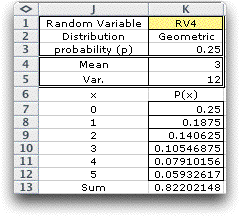 |

|
Example: If you don’t win or lose on the first roll
of the craps game, you might wonder how long the game will
last.
Assume the dice totals to 4 on the first roll. The player will
continue to roll the dice until a 4 shows, and the player wins,
or a 7 shows, and the player loses. Based on the probabilities
computed earlier for a roll of a pair of dice, on any given
roll, the game will end with probability 0.25 and
continue
with probability
0.75.
We define the random variable as the number of rolls prior
to the last roll. That number may be 0, 1, 2,… which is
random variable described by the geometric distribution. The
results on the left show that the mean number of rolls is 3
and the variance is 12. The first six probabilities of the distribution
are computed at the left. The game might continue for quite
a few rolls. The probability that more than 5 rolls is required
is about 0.18.
|



